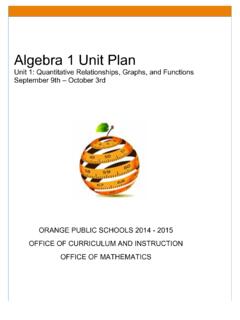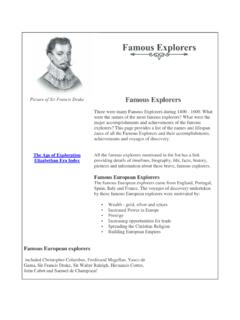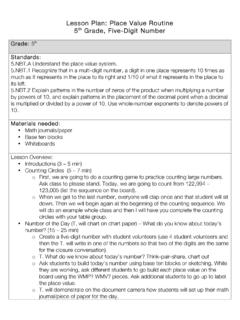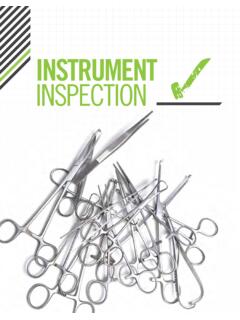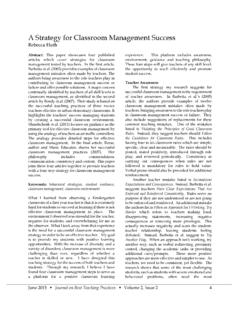Transcription of 5th Grade Mathematics - Orange Public Schools / Overview
1 5th grade mathematics Fractions- Unit 3 Curriculum Map January 6th March 7th Orange Public Schools . OFFICE OF CURRICULUM AND INSTRUCTION. OFFICE OF Mathematics . 5th Grade Unit 3 January 6th March 7th Table of Contents I. Unit Overview p. 3. II. Important Dates and Calendar p. 4. III. Curriculum Guide p. 5. IV. Review Content Overview p. 6. V. Structure of the Modules p. 8. VI. Common Core Standards Review Content p. 9 - 28. VII. Assessment Check for Review Content p. 29 - 35. VIII. Common Core Standards Fractions p. 37. IX. Connections to Mathematical Practices p. 39. X. Vocabulary p. 40. XI. Potential Misconceptions p. 43. XII. New Content Resources p. 44 - 61. XIII. Assessment Check 2 p. 62 - 79. XIV. Extensions and Sources p. 80. 1. 5th Grade Unit 3 January 6th March 7th Common Core Grade Fluency REVIEW OF Grade 4 FLUENCY.
2 Fluently add and subtract multi digit whole numbers using the standard algorithm. EXPECTED 5TH Grade FLUENCY. Fluently multiply multi-digit whole numbers using standard algorithm. 2. 5th Grade Unit 3 January 6th March 7th Unit Overview In this unit, students will .. Use multiple strategies to find equivalent fractions Find and generate equivalent fractions and use them to solve problems Simplify fractions Use concrete, pictorial, and computational models to find common denominators Use fractions (proper and improper) and add and subtract fractions and mixed numbers with unlike denominators to solve problems Use concrete, pictorial, and computational models to multiply fractions Use concrete, pictorial, and computational models to divide unit fractions by whole number and whole numbers by unit fractions Estimate products and quotients 3.
3 5th Grade Unit 3 January 6th March 7th Important Dates and Calendar Monday Tuesday Wednesday Thursday Friday Week of . 1/6-1/10. 1/13-1/17 REVIEW MODULES. 1/21-1/24 No School Checkpoint 1/27-1/31 1/2 Day 2/3-2/7 UNIT 3 NEW CONTENT. 2/10-2/14. 2/17-2/21 NO SCHOOL. 2/24-2/28 UNIT 3 NEW CONTENT. 3/34-3/7 Assessment Week IMPORTANT DATES. Monday, Jan 20th MLK Day Friday, Jan 24th Checkpoint 2 Grades 6-7. Friday, Jan 31st 1/2 Day Week of Feb 17th VACATION. Friday, March 14th Data Due Friday, March 21st Data Returned to Principals 4. 5th Grade Unit 3 January 6th March 7th th 5 Grade Review Content Activity Teach Notes Common Core Estimated Standards/SLO Time Module Review - 2 5 - 10 days Practice Problems Review 6 2 days Practice Problems Review 2 days Assessment Check See above 1 day (Review).
4 New Content Checkpoint #2 SGO Standards 1 day (Friday, January 24th). 5th Grade Fraction Module Lessons 1 - 3 & 2 7 days 5. NF. 1 - 2. 5th Grade Fraction Lesson 4: Golden Problem & 2 1 day Module5. NF. 1 - 2. 5th Grade Fraction Module Lessons 1 - 4 7 days 5. NF. 4. 5th Grade Fraction Module Lesson 5: Golden Problem 1 day 5. NF. 4. Various Text Resources 5 days Unit 3 Assessment , , a, 2 days b, a,b, 5. 5th Grade Unit 3 January 6th March 7th Review Content Overview Weeks One - Three 1 & 2. Students will develop a mathematical understanding of place value relating to multi-digit whole and decimal numbers. Students will be asked to explain patterns in the number of zeroes of resulting products when multiplying a number by powers of 10, and explain patterns in the placement of the decimal point when a decimal is multiplied or divided by a power of 10.
5 5 & 6. Students will be able to determine the size of a product based on the factors (relative to 1), and show division of whole numbers with one and two-digit divisors using place value, arrays, area models, and other strategies. 5. NF. 3. Students will be able to interpret fractions as the division of the numerator by the denominator. 6. 5th Grade Unit 3 January 6th March 7th Review 7. 5th Grade Unit 3 January 6th March 7th Structure of the Modules The Modules embody 3 integrated frameworks that promote the development of conceptual and problems solving skills and computational fluency. The conceptual framework of the Modules builds from the concrete to the pictorial to the abstract (and the constant blending of each) to help students develop a deeper understanding of Mathematics .
6 The Modules also reference a multiple representations framework that encourages teachers to present content in multiple modalities to support flexible thinking. These frameworks go beyond concrete representation ( manipulatives) to promote the realistic representation of concepts addressed in multiple settings. Lastly, the Modules embody a gradual release' framework that encourages teachers to progress from whole group to collaborative and finally to an independent practice format. Overview . Each module begins with an Overview . The Overview provides the standards, goals, prerequisites, mathematical practices, and lesson progression. INTRODUCTORY TASKS. The Introductory Tasks serve as the starting point for the referenced standard and are typically either diagnostic, prerequisite or anticipatory in nature.
7 GUIDED PRACTICE. Serves for additional teacher guided instruction for students who need the additional help. The tasks can be modeled with students. COLLABORATIVE PRACTICE. Serve as small group, or partnered work. The work should promote student discourse, which allows students to make sense of problems and persevere in solving them ( ). Through teacher- facilitated, whole group discussion, students will have the opportunity to critique the reasoning of others ( ). JOURNAL QUESTIONS. Provide the opportunity to individual, independent reflection and practice. This independent format encourages students to construct viable arguments ( ) and to reason abstractly/quantitatively ( ). HOMEWORK. Can be used as additional in-class practice, Independent Practice, etc. This work should be reviewed and discussed.
8 Procedural fluencies are reinforced within this section. GOLDEN PROBLEM. The Golden Problem is a performance task that reflects an amalgamation of the skills addressed within the Module. The Golden Problem assesses the student s ability to apply the skills learned in a new and non-routine context. More than one-step; problems usually require intermediate values before arriving at a solution (contextual applications). In the US, we see one step problems that require either recall or routine application of an algorithm. 8. 5th Grade Unit 3 January 6th March 7th Common Core Standards: & 2. Understand the place value system. Goals: Prerequisite Skills: Within this module, students will develop a mathematical Understand place value for multi- understanding of place value relating to multi-digit whole digit whole numbers and decimal numbers.
9 Students will be asked to explain Read and write multi-digit whole patterns in the number of zeroes of resulting products numbers using base-ten numerals, number names, and expanded form when multiplying a number by powers of 10, and explain Compare multi-digit numbers using patterns in the placement of the decimal point when a symbols decimal is multiplied or divided by a power of 10. Use place value to round whole numbers Essential Questions: How does one identify the place value of whole numbers and decimals? How does a digit's position affect its value? What different relationships exist between units in the base-ten number system? Embedded Mathematical Practices Make sense of problems and persevere in solving them Reason abstractly and quantitatively Construct viable arguments and critique the reasoning of LESSON 4.
10 Others Model with Mathematics Golden Problem Use appropriate tools strategically . Attend to precision LESSON 3. Look for and make use of structure Look for and express regularity in Golden Problem repeated reasoning LESSON 2. Explain patterns in the placement of the decimal point Lesson Structure when a decimal is divided by a power of 10. Introductory Task Guided Practice LESSON 1. Collaborative Work Journal Questions Read, write, and identify place value of whole numbers and decimals. Explain patterns in the number of zeroes of product Skill Building when multiplying a number by powers of 10. Homework 9. 5th Grade Unit 3 January 6th March 7th Lesson 1: Introductory Task Reaching One Million with Powers of Ten . Introductory Task Guided Practice Collaborative Work Homework Assessment PREREQUISITE COMPENTENCIES FOR THIS TASK.
